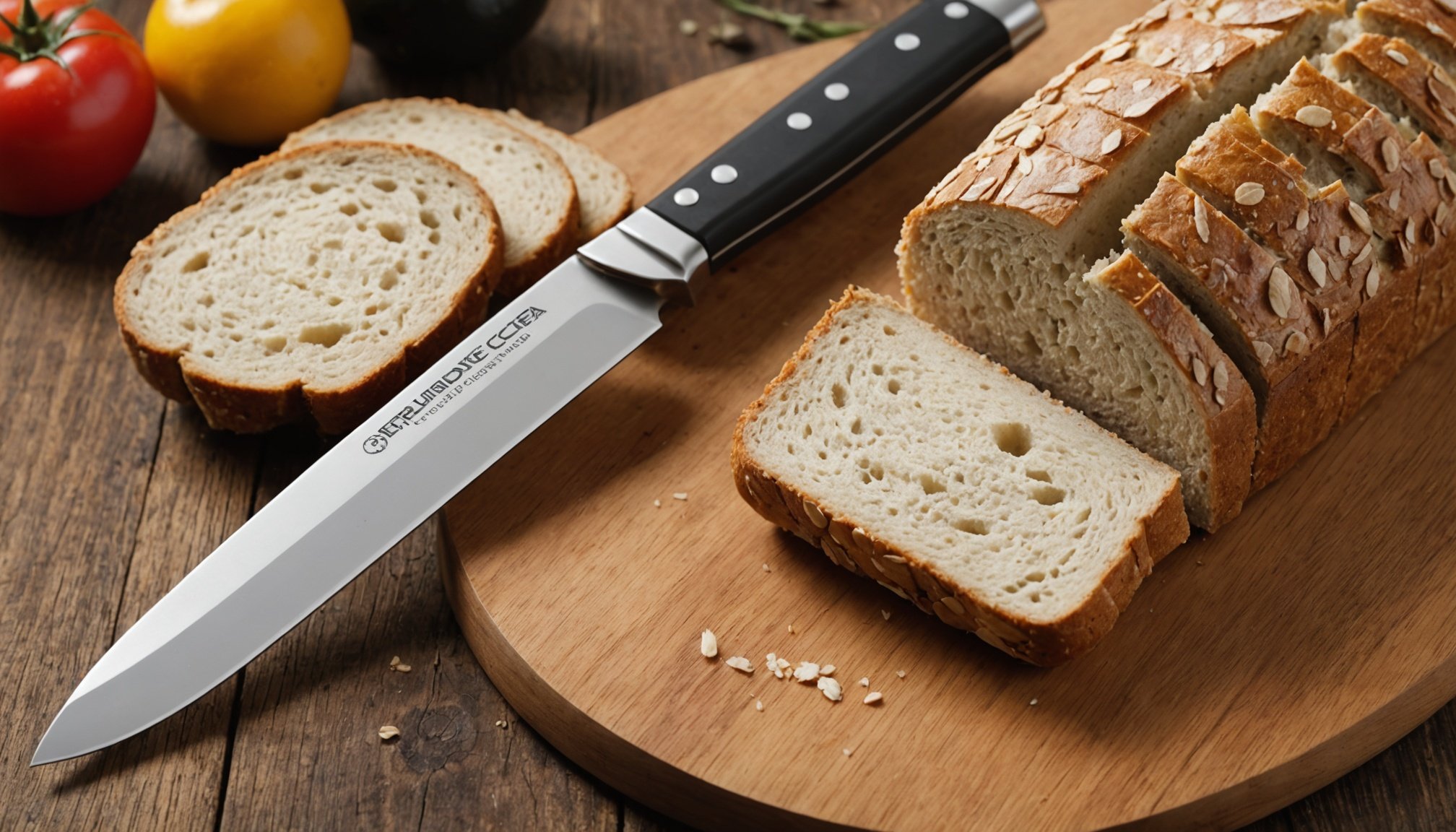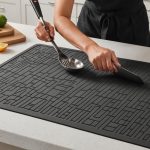In the realm of kitchen essentials, the humble knife reigns supreme. It is the most versatile tool, the chef’s right hand, so to speak. One might even say it is the heart and soul of any good kitchen. But not all knives are created equal, especially when it comes to slicing bread. The first thing you’ll notice when slicing a loaf of freshly baked sourdough or cutting through a crusty French baguette, is the difference a serrated bread knife makes in comparison to a straight blade. This article will delve deeply into the benefits of serrated bread knives and why they are considered the best choice by chefs worldwide.
The Science Behind Serrated Blades
Serrated knives are often overlooked, relegated to the back of the kitchen drawer. But to truly appreciate their value, one must understand the science behind these jagged-edged tools. The serrated edge is not a gimmick; it serves a very specific, practical purpose.
This might interest you : How to Pick a Kitchen Mat That Reduces Fatigue During Long Cooking Sessions?
Serrated blades are designed for cutting through foods with a hard exterior and soft interior, like bread. The pointed teeth on the blade pierce the crust while the gullets, the spaces between the teeth, reduce friction and help move the slices away from the blade. This design allows for cleaner, more efficient cuts, particularly on crusty or tough surfaces.
Serrated Knives: The Bread-Slicing Champions
When it comes to slicing bread, serrated knives truly shine. They are the undisputed champions in this arena. A bread knife’s serrated blade navigates easily through a crusty exterior while preserving the soft interior, providing clean, perfect slices every time.
Have you seen this : How to Select a Pasta Drying Rack That Saves Space?
Straight knives, on the other hand, often struggle with the crust, leading to squashed, misshapen slices. The bread’s soft interior provides little resistance, causing the straight blade to slip and slide, making even cuts difficult to achieve. But with a serrated knife, the teeth on the blade grip the crust, allowing you to cut with precision and ease.
Navigating the World of Serrated Bread Knives
As with any kitchen tool, not all serrated bread knives are made equal. There are many factors to consider when choosing the best serrated knife for your kitchen. Blade length, serration style, blade material, and handle comfort are just a few things that can affect performance and ease of use.
When it comes to blade length, a longer knife is generally better for cutting large loaves of bread—as it can slice through in one smooth motion. The serration style can also vary, with some knives featuring large, widely-spaced serrations, while others have smaller, more closely-spaced serrations. Knives with larger serrations are generally more aggressive cutters, ideal for very crusty breads, while those with smaller serrations offer more control and precision.
Blade material is also crucial. High-carbon stainless steel is popular for its durability and sharpness, but other materials like ceramic can also provide excellent performance.
When to Use a Serrated Knife Over a Straight Blade
While serrated knives excel at cutting bread, they are also versatile tools that can handle a wide range of other kitchen tasks. Serrated knives are ideal for slicing fruits and vegetables with tough skins and soft interiors, like tomatoes and peaches. The teeth of the blade pierce the skin without squashing the tender flesh inside.
Serrated knives are also excellent for slicing through food that tends to crumble, like cakes and pastries. A straight blade can often cause these delicate items to fall apart, but a serrated blade slices through cleanly, preserving the structure of the food.
In comparison, straight blades are better suited for chopping, dicing, and mincing tasks, such as cutting onions, herbs, or meat. They offer a clean, precise cut and can be easily controlled for detailed work. However, when it comes to tasks that require a sawing motion—like slicing bread—a serrated blade is undeniably superior.
The Lasting Appeal of the Serrated Blade
Serrated knives have been a kitchen staple for centuries, and their popularity shows no signs of waning. The unique design of the serrated blade, with its pointed teeth and gullets, makes it a formidable tool in the kitchen, particularly when it comes to slicing bread.
A quality serrated bread knife can transform the simple act of slicing bread from a task into a pleasure. It can make baking homemade bread even more rewarding, ensuring that each loaf is sliced to perfection, with a minimum of effort and a maximum of satisfaction.
The next time you reach for a knife to slice a loaf of bread, consider choosing a serrated blade. You may be surprised at the difference it makes.
The Versatility of Serrated Bread Knives
A common perception about serrated bread knives is that they are only used for slicing bread. However, this is a myth. Serrated knives, with their jagged edges, are capable of much more. In fact, they are an incredibly versatile addition to any kitchen.
A serrated knife, unlike a straight blade or chef’s knife, has a sawing motion that makes it a proficient tool for cutting through foods that have a tough exterior and a soft interior. This includes not just crusty bread, but also fruits with a hard skin like tomatoes and peaches. The serrated edge easily pierces the skin without squashing the delicate flesh inside. This makes the serrated knife a must-have for any home cook or professional chef.
Moreover, serrated knives are also great for foods that tend to crumble easily. If you’ve ever tried slicing a freshly baked cake or a delicate pastry with a straight-edged knife, you know the struggle. The blade often causes these tender items to fall apart. However, with a serrated knife, the sharp teeth and the sawing motion allow for a clean, precise cut, preserving the structure of the food.
Even beyond the kitchen, a serrated knife can prove to be a handy tool. If you are a DIY enthusiast, you might find it useful for cutting through materials with a similar texture to bread – hard on the outside, soft on the inside.
In short, don’t restrict your serrated knife to the cutting board or to just slicing bread. It’s a utility knife that can help you with many tasks in and out of the kitchen.
Conclusion: The Serrated Bread Knife – A Kitchen Essential
In the vast world of kitchen knives, the serrated bread knife holds a special place. Its unique design – a jagged edge that allows for a sawing motion – makes it an essential tool for any cook, amateur or professional. Be it slicing through a crusty loaf of bread, dicing up a ripe tomato, or cutting into a delicate pastry, the serrated knife makes the task easier and the outcome better.
Choosing the right bread knife for your needs can be a game-changer in your kitchen routine. From the length of the blade, the style of serration, to the material of the blade, there are aspects to consider. However, once you find the perfect match, the serrated bread knife could become your favourite kitchen companion.
By understanding the science behind the serrated edge and acknowledging the broad range of tasks a serrated knife can handle, we appreciate the true value of this kitchen tool. It’s not just another knife; it’s a carefully crafted tool designed for precision and efficiency.
So, next time you bake a loaf of bread or find yourself struggling with a straight edged knife, remember the serrated knife waiting in your drawer. Pick it up, feel the difference it makes, and join the ranks of chefs worldwide who swear by the utility and effectiveness of the serrated bread knife. The versatile, reliable, and indispensable serrated knife – truly the unsung hero of the kitchen.










